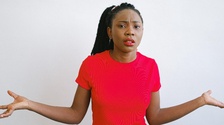As you know, in English there are two cases for demonstrative pronouns:
to point to the near object
- "This" is used to point to the near (singular) object.
- "These" is used to point towards the near (plural) objects.
to point to the distant object
- "That" is used for the distant (singular) object.
- "Those" is used for the distant (plural) objects.
And in Arabic, demonstrative pronouns (أسْماءُ الإشارَة) are used in the same way as English demonstratives.
However, Arabic has many more demonstratives than English due to the masculine (المُذَكَّر) and feminine (المُؤنَّث) differentiation, and due to the dual case.
And it is very important in Arabic to make sure that the demonstrative pronoun agrees with the noun it refers to in number, gender and case.
So, in Arabic we find 10 demonstrative pronouns, compared to only 4 in English.
Here are all the demonstrative pronouns in Arabic:
Secondly Demonstrative pronouns (near) (أَسْمَاءُ الإِشَارَةِ (لِلْقَرِيب
|
Arabic |
Gender |
Number |
English |
|
|
1 |
هَـٰذَا |
Masculine |
Singular |
This |
Examples:
This is a man. .هَـٰذَا رَجُلٌ
This is my friend. .هَـٰذَا صَدِيقي
This is the book. .هَـٰذَا هُو الكِتَابُ
|
Arabic |
Gender |
Number |
English |
|
|
2 |
هَـٰذِهِ |
Feminine |
Singular |
This |
Examples:
This is my mom. .هَـٰذِهِ أُمِّي
This is the new car. . هَـٰذِهِ هِيَ السَّيَّارَةُ الجَدِيدَةُ
This is the girl. .هَـٰذِهِ هِيَ البِّنتُ
|
Arabic |
Gender |
Number |
English |
|
|
3 |
هَـٰذَانِ / هَـٰذَينِ |
Masculine |
Dual |
These two |
Examples:
These are two Muslims. .هَـٰذَانِ مُسْلِمَان
These are two boys. .هَـٰذَانِ وَلَدَان
I read these two books. .قَرَأْتُ هَذَينِ الكِتَابَيْن
|
Arabic |
Gender |
Number |
English |
|
|
4 |
هَـاتَانِ / هَـاتَينِ |
Feminine |
Dual |
These two |
Examples:
These are two Muslims. .هَـاتَانِ مُسْلِمَتَان
These are two teachers. .هَـاتَانِ مُعَلِّمَتَانِ
This milk from these two cows. .هَذَا الحَلِيبُ مِن هَـاتَينِ البَقْرَتَينِ
|
Arabic |
Gender |
Number |
English |
|
|
5 |
هَـٰؤُلاءِ |
Masculine / Feminine |
Plural |
These |
Examples:
These are men. . هَـٰؤُلاءِ رِجَالٌ
These are my children. .هَـٰؤُلاءِ أوْلَادِي
These students are in the school. .هَـٰؤُلاءِ الطُّلَّابُ فِي المَدْرَسَة
But with the plural of irrational nouns (masculine and feminine), we must use ‘this’ (هَـٰذِهِ), instead of ‘these’ (هَـٰؤُلاءِ).
Examples:
Those are dogs. .هَذِهِ كِلابٌ
These are my books. .هَذِهِ كُتُبِي
Do you like those flowers? هَلْ تُحِبُّ هَذِهِ الزُهُور؟
- (هَـٰؤُلاءِ) is likewise allowed for irrational (nouns), but this is rare.
Secondly Demonstrative pronouns (distant ) (أَسْمَاءُ الإِشَارَةِ (لِلْبَعِيدِ
|
Arabic |
Gender |
Number |
English |
|
|
6 |
ذَلِكَ |
Masculine |
Singular |
That |
Examples:
That shirt looks great. .ذَلِكَ القَمِيصُ يَبْدُو جَمِيلًا
I don't like that movie. .لا أُحِبُّ ذَلِكَ الفِلْم
|
Arabic |
Gender |
Number |
English |
|
|
7 |
تِلْكَ |
Feminine |
Singular |
That |
Examples:
That is a ship. .تِلْكَ سَفِينَةٌ
That is a fast car. .تِلْكَ سَيَّارَةٌ سَرِيعَةٌ
|
Arabic |
Gender |
Number |
English |
|
|
8 |
ذَانِكَ |
Masculine |
Dual |
Those two |
Examples:
Those are two stars. .ذَانِكَ نَجْمَان
Those two books are good. .ذَانِكَ الكِتَابَانِ جَيِّدَان
|
Arabic |
Gender |
Number |
English |
|
|
9 |
تَانِكَ |
Feminine |
Dual |
Those two |
Examples:
Those are two planes. .تَانِكَ طَائِرَتَان
Those are two mountains. .تَانِكَ جَبَلان
|
Arabic |
Gender |
Number |
English |
|
|
10 |
أُؤلَـٰئِكَ |
Masculine / Feminine |
Plural |
Those |
Examples:
Those are the guests. .أُوْلَـٰئِكَ الضُّيُوفُ
Those are smart students. .أُوْلَـٰئِكَ طُلَّابٌ أذْكِياءٌ
But with the plural of irrational nouns (masculine and feminine), we must use ‘that’ (تِلْكَ) instead of ‘those’ (أُؤلَـٰئِكَ).
Those trees. .تِلْكَ الأشْجَار
Those books. .تِلْكَ الكُتُب
(تِلْكَ) is likewise allowed for plural rational nouns, as we can see in the Qur'an (تِلكَ الرُّسُلُ those messengers), but this is rare.
If you have questions, feel free to write it to me or in the comments section!
Hero image by author







